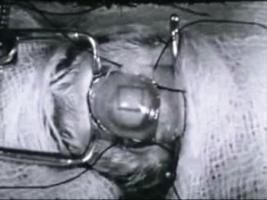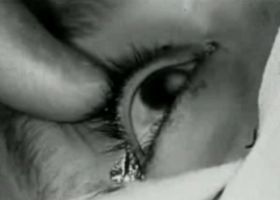Descripción de textos incluidos:
0:53 The leucoma is produced by burning the eye with lime
1:22 Instruments required for the operation
1:36 A special keratome: 4 millimeters wide
1:45 Special scissors: the points are dull to avoid injury to iris and lens
1:55 Combination needle holder, scissors and forceps
2:04 Three months later, the inflammation disappeared, the rabbit is ready for the corneal transplant. The rabbit is again anaesthetized with Pernostan. The pupil must be fully dilated with atropine (3%), 15 minutes before the operation three instillations of epinephrine (1/1000), 5 minutes apart-are made to obtain an ischaemic conjunctiva.
2:28 The hair around the eye is clipperd as short as possible. Eyelids and adjoining areas are painted with iodine
2:52 A new drops of argyrols (20%) epinephrine (1/1000) and cocaine (4%9 are instilled into the eye
3:10 Speculum is inserted
3:16 Upper and lower conjunctival flaps are dissected and stretched to cover the central corneal area. Two sutures, abouth 5 millimeters apart, are placed reaching from the lower to the upper conjunctivl flap
4:00 Before proceeding with the operation one must be dure that the conjunctival flaps cover the center of the cornea, where the transplant is to be made.
4:16 Cross-incisions are made at right angles to each other with the keratoplastotome, the object being to outline a corneal flap 4 millimeters square. These incisions do not penetrate into the anterior chamber..
4:56 The incisions become sharply outlined after the instillation of fluoresceine"
5:05 While the eye is immobilized by taking hold of the episclera near the limbus-a puncture is madeat the upper incision with the keratome held at an angle of 45º"
5:19 The other three edges are cut with the special scissors held at an angle of 45º. Holding the keratome and scissors at an angle of abouth 45º results in uniformly bevelled edges of the flap
5:58 Similar technique is employed in obtaining the transparent flap from an enuceated eye
7:27 The transparent flap replaces the dissected leucoma
7:56 The sutures are tied and additional sutures are placed: usually one more on each side of the original two suffice to cover the transplant completely with the conjunctiva"
9:52 Metaphen ointment is applied, eyelids closed and dressing of cotton satured with collodion is placed, giving satisfactory protection
10:22 Six day later sutures are removed and a second dressing is applied, remaining for anther six days"
10:35 Transparent transplant more than one year old

